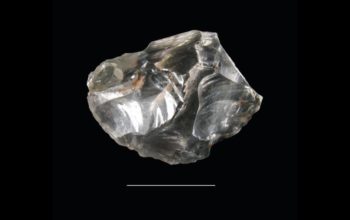An ancient human skull was discovered by two kayakers along the drought-stricken Minnesota River in September 2021 while enjoying the last days of summer.
Written content from Louise Franco

Local forensic authorities only confirmed this week through carbon dating that the initially unidentified human fossil dated back to 8,000 years ago.
The authorities claimed that the skull was likely from a young man who lived around 6000 to 5500 B.C. and relied solely on a remarkable diet in the area, reportedly at a time long before conventional agricultural and farming methods were invented.
After the duo discovered the skull along the Minnesota River bank near the city of Sacred Heart, approximately 110 miles west of Minneapolis, they called the Renville County Sheriff’s Office to report what first appeared to be a brown chunk of bone.
The sheriff’s office then submitted the fossil to a medical examiner and then to a forensic anthropologist at the Federal Bureau of Investigation (FBI).
The nature of the discovery was first treated as a crime incident since the local police suspected it to be the human remains of a person from a nearby country.
Several months have passed until Tuesday, May 17, when the investigating authorities found the human skull was ancient and not from the remains of a recently killed person.
The findings of the anthropologist were cited by Renville County Sheriff Scott Hable, as reported by The New York Times.
Based on the report by the Augustana University – Archaeology Laboratory in South Dakota, the young man likely traveled through areas of what is now Minnesota during the Archaic period in North America.
It was also the period when mainly ate nuts and seeds since subsistence farming does not exist yet.
Furthermore, the man has likely eaten a diet based on deer, fish, freshwater mussels, plants, and turtles in a small rather than chasing bison and mammals due to their long-distance migration, according to Kathleen Blue, an anthropology professor at Minnesota State University, as cited by The New York Times.
Blue reportedly added there were previously three other human remains found within the same time period in Minnesota.
Meanwhile, the exact cause of death of the man remained unknown even if they found indications of a severe head wound or a blunt force trauma, according to the FBI anthropologist.
There was an ongoing drought during the time of the discovery of the ancient human skull in the Minnesota River.
According to the Department of Natural Resources (DNR), a major drought took place in Minnesota in 2021.
The extreme heat allowed the water level at the river to recede and reveal the hidden fossil.
In a related case similar to the Minnesota River incident, a drought in the Western United States this year led to the discovery of human skeletal remains in a barrel at a receding Lake Mead in Nevada, according to the Los Angeles Times. Read more from Natureworldnews





